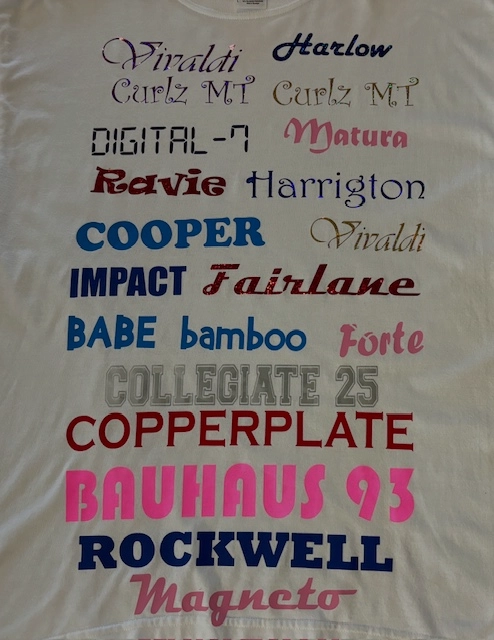Embroidered Sports Teams Names and Numbers - Expert and Sturdy
Embroidered Sports Teams Names and Numbers - Expert and Sturdy
Blog Article
The Art of Custom Needlework: Unlocking the Keys to Creating Special and Memorable Layouts
Embroidery, a craft soaked in custom and artistry, holds within its detailed stitches the power to transform textile into a canvas of unique expression. The tricks to creating custom needlework layouts that mesmerize the eye and leave an enduring perception depend on a fragile equilibrium of method, creative thinking, and focus to detail. As we explore the world of custom-made needlework, we discover the nuanced interplay between string choice, sew intricacy, and style personalization that boosts a simple garment to a work of art. Join us on a trip via the art of personalized needlework as we unravel the mysteries behind crafting absolutely memorable and unique developments.
Picking the Right Needlework Threads
When choosing embroidery threads, what essential elements should you consider to make certain the most effective results for your personalized styles? The choice of needlework thread is vital in establishing the final end result of your stitched layout. Among the key factors to consider is the material of the thread. Various materials such as cotton, polyester, rayon, and silk supply varying levels of sheen, durability, and appearance. It is important to pick a thread material that enhances the textile you are stitching on and straightens with the wanted look of the style.
Moreover, the weight or thickness of the string plays a significant role in the look of the needlework. Thicker strings can include measurement and appearance to your layout, while finer strings are optimal for complex details and small message. In addition, thinking about the shade fastness and washability of the thread is vital to ensure that your customized designs maintain their quality and vibrancy with time. By meticulously assessing these aspects and picking high-quality threads that meet your particular demands, you can improve the visual appeal and durability of your embroidered creations.
Discovering Different Stitch Techniques
To look into the world of 'Discovering Various Stitch Techniques', one have to comprehend the ins and outs and nuances that each sewing method offers the art of needlework. Various stitch techniques not only include visual interest however additionally add to the total texture and dimension of the layout. One preferred stitch technique is the satin stitch, which includes carefully packed parallel stitches to develop a smooth and glossy surface, suitable for filling out shapes and creating strong describes.
On the other hand, the backstitch is a flexible strategy usually utilized for describing and adding great details. It includes stitching backwards to produce a solid line of embroidery. Additionally, the French knot stitch includes a tactile component to layouts, best for producing distinctive accents like flower facilities or attractive touches.
Discovering different stitch techniques permits embroiderers to play with light, shadow, and deepness within their styles, boosting the aesthetic charm and imaginative high quality of their embroidery jobs. By mastering numerous stitching techniques, one can open unlimited possibilities for developing unique and remarkable personalized embroidery items.
Incorporating Personalized Design Components
Having actually explored the ins and outs of various stitch techniques such as the satin stitch, backstitch, and French knot, the focus now changes towards integrating customized layout components in personalized needlework jobs. Customized design components play a critical duty in making needlework tasks truly distinct and memorable.
An additional method to incorporate tailored style elements is by consisting of symbols or themes that hold special definition to the recipient or reflect their passions and personality. Including a favorite blossom, animal, or hobby-related sign can make the embroidery style a lot more meaningful and customized. In addition, selecting shades that resonate with the recipient or straighten with the designated motif can even more boost the personalization of the needlework job.
Mastering the Art of Shade Coordination

One secret facet of color control is understanding shade theory. This consists of knowing how different colors interact with each various other, the emotions they share, and how they can be incorporated to produce aesthetically attractive styles. By using shade concept concepts, embroiderers can create harmonious color schemes that enhance the total appearance of the layout.
In addition, paying interest to contrast is vital in shade control. Making use of contrasting shades can assist certain components of the style pop, enhance clarity, and develop a visually dynamic needlework piece. By understanding the art of shade control, embroiderers can raise their designs and develop unforgettable items that reverberate with clients and viewers alike.
Enhancing Structure With Advanced Embroidery Stitches
French knots, as an example, are perfect for including little, raised dots to your design, simulating the look of grains or creating a distinctive surface. Bullion knots, on the various other hand, can be used to create twisted, ropelike elements that include an elegant feel to the needlework. Seed stitching involves little, scattered stitches that can fill out areas with a polychromatic structure, while turkey work develops cosy, dimensional accents similar to pet hair or foliage. Try out these innovative needlework stitches allows you to press the limits of conventional needlework and develop official statement genuinely distinct and aesthetically attractive textures in your layouts.
Verdict
In verdict, the art of custom-made embroidery entails a mix of selecting the best strings, checking out numerous stitch techniques, integrating personalized style aspects, grasping shade sychronisation, and improving appearance with innovative stitches. By comprehending and implementing these key components, embroiderers can develop special and memorable layouts that showcase their creative thinking and skill. Needlework enthusiasts can open the secrets to producing gorgeous and custom items that attract attention and leave an enduring impact.
Report this page